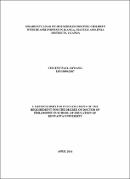| dc.contributor.author | Ojwang, Vincent P. | |
| dc.date.accessioned | 2022-03-28T07:11:00Z | |
| dc.date.available | 2022-03-28T07:11:00Z | |
| dc.date.issued | 2014-04 | |
| dc.identifier.citation | Ojwang, Vincent P. (2014). Disability load on households hosting children with deafblindness in Iganga, Mayuge and Jinja districts, Uganda.Kenyatta University(un published work) | en_US |
| dc.identifier.uri | https://hdl.handle.net/20.500.12504/951 | |
| dc.identifier.uri | Find full text in Barclays library Rare Section | |
| dc.description | xii,209 p. : col. | en_US |
| dc.description.abstract | Unlike in the developed world, there is little documented information about children
with deafblindness (CWDB) and, virtually no research has been done in Uganda
regarding all aspects of deafblindness. Therefore, little is known about the disability
load borne by the household and its effect on the quality of life and the educational
development of the children. The purpose of the study was .to determine the nature of
the di sability load in the household hosting CWDB and the resulting impact on the
members. The specific objectives were to dimensionalise the di sability load, find the
effects on the quality of life. the impact on the schooling path, investigate gender
differences and generate a conceptual framework for improving schooling outcomes.
The building of this conceptual framework was guided by other relevant existing
theories. The approach of the inquiry was qualitative, using the Grounded Theory
design which is appropriate for examining complex phenomenon. The method of
inquiry was systematic, intended to carry out data collection procedure and analysis
using constant questioning and comparison. A sample of five households was
purposively selected. From every household, between four to five participants were
selected to give a total of 23 participants. They were "selected because they had borne
the disability load by raising and Jiving with CWDB. Two instruments were used.
namely. in-depth interviews as well as observational guide. A pilot study to test the
instruments, check the use of resources and increase familiarity with the procedure
for inquiry was undertaken. Permission to carry out data collection was sought from
the national and district authorities. Each interview was preceded by clarification of
theaim of the interview and promise of confidentiality. Individual members of the
household were interviewed in depth. The information was recorded using a tape
recorder, while observing accompanying behavior. Internal and communication
validity were ensured by constant questioning. comparison and theoretical sampling.
Reliability in Grounded Theory approach was brought about by the development of
concepts which were rigorously worked out to form categories. Concepts formed in
this way last long and are therefore reliable. Immediately after each interview, the
recorded information was transcribed. Data analysis included open, axial and
selective coding. The study established that household members while hosting
CWDB, experienced disability load of many dimensions, with the emotional one
being the greatest. The disability load had a severe impact on the quality of life in the
households as well as the schooling path of the children. The gender difference on the
impact on the schooling path was detected but was not significant. The final outcome
of the inquiry was a conceptual framework grounded in the data. The framework has
been named the Disability Load Conceptual Framework. It is recommended that
policies be developed to guide practical intervention into the socio-economic lives of
household members in order to improve the schooling path of the children. | en_US |
| dc.language.iso | en | en_US |
| dc.publisher | Kenyatta University(un published work) | en_US |
| dc.subject | Disability | en_US |
| dc.subject | Disability Load Conceptual Framework | en_US |
| dc.subject | Children with Deafblindness | en_US |
| dc.title | Disability load on households hosting children with deafblindness in Iganga, Mayunge and Jinja districts, Uganda | en_US |
| dc.type | Thesis | en_US |

